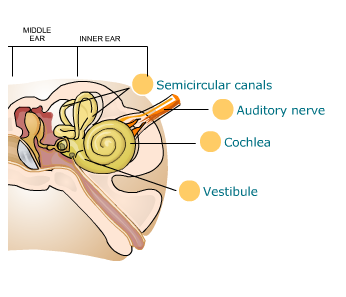The inner ear
The cochlea - the organ for hearing - is a coiled tube with a bulbous base like a snail’s shell. It contains a strip of sensory hair cells, the organ of Corti. The cells are stimulated by vibrations of the fluid in the cochlea, and transmit nerve impulses to the brain.
The semicircular canals - which detect rotation - are three curved ducts that lie at right angles to each other. Each widens into an ampulla at one end.
Each ampulla contains a patch of sensory hair cells that responds to the flow of fluid through the canal when the head moves. Since there is a canal in each plane, information is provided to the brain about rotation of the head in any direction.
The vestibule contains two patches of sensory cells, the maculae, that lie at right angles to each other and enable the brain to detect the position of the head.

